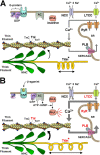Modulation of cardiac function: titin springs into action
- PMID: 15738046
- PMCID: PMC2234017
- DOI: 10.1085/jgp.200509268
Modulation of cardiac function: titin springs into action
Figures

Comment on
-
Phosphorylation of titin modulates passive stiffness of cardiac muscle in a titin isoform-dependent manner.J Gen Physiol. 2005 Mar;125(3):257-71. doi: 10.1085/jgp.200409177. J Gen Physiol. 2005. PMID: 15738048 Free PMC article.
References
-
- Bers, D.M. 2002. Cardiac excitation-contraction coupling. Nature. 415:198–205. - PubMed
-
- Cazorla, O., A. Freiburg, M. Helmes, T. Centner, M. McNabb, Y. Wu, K. Trombitas, S. Labeit, and H. Granzier. 2000. Differential expression of cardiac titin isoforms and modulation of cellular stiffness. Circ. Res. 86:59–67. - PubMed
-
- Freiburg, A., K. Trombitas, W. Hell, O. Cazorla, F. Fougerousse, T. Centner, B. Kolmerer, C. Witt, J.S. Beckmann, C.C. Gregorio, et al. 2000. Series of exon-skipping events in the elastic spring region of titin as the structural basis for myofibrillar elastic diversity. Circ. Res. 86:1114–1121. - PubMed
-
- Fujita, H., D. Labeit, B. Gerull, S. Labeit, and H.L. Granzier. 2004. Titin isoform-dependent effect of calcium on passive myocardial tension. Am. J. Physiol. Heart Circ. Physiol. 287:H2528–H2534. - PubMed

